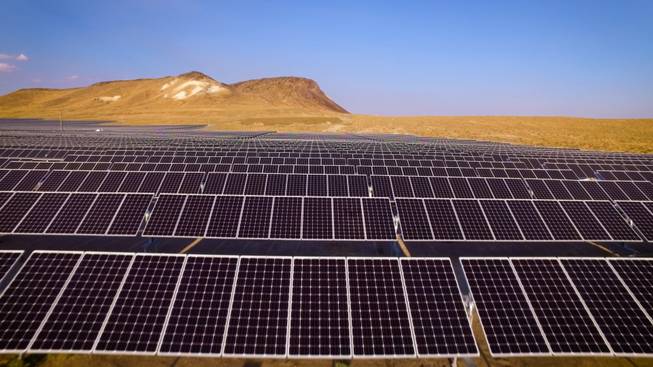
Business Wire / AP
SolarWorld Americas Inc. supplied 14.2 megawatts DC of high-performance solar panels for a project near Fernley. A trade commission is expected to decide next week whether to proceed with a case that could lead to tariffs on solar cells.
Friday, Sept. 15, 2017 | 2 a.m.
A trade commission is expected to decide next week whether to proceed with a case that could lead to tariffs on solar cells.
The tariffs would make solar panels more expensive and hurt the industry, says Solar Energy Industries Association CEO Abigail Ross Hopper, who is leading the solar industry in the case. The U.S. International Trade Commission will vote Sept. 22 on whether companies Suniva and SolarWorld were hurt by imports of solar cells, which are assembled to create solar panels.
If commissioners find in the two companies’ favor, Hopper says a remedy recommendation will be made before President Donald Trump makes the final decision. The requested tariffs on these imported cells would double the price of solar panels, halve the demand and cause 88,000 people to lose their jobs nationwide, Hopper said.
About 2,000 jobs in Nevada alone could be lost as a result of the tariffs, Hopper said. The state’s solar industry has been ramping up since the passage of legislation to restore credits for power customers whose solar panels send excess energy to the grid.
“The Nevada solar industry has had a tumultuous two years and finally has some certainty. The future looks bright for solar here in this great state,” Hopper said. “This, without a doubt, creates lots of uncertainty about the future of that market. All the hard work that the Legislature just did and the governor did and the commission did to create a sustainable and clear path for residential solar could be put at risk if these tariffs are put in place.”
The case was heard Aug. 15, with both sides presenting testimony. Juergen Stein, CEO of SolarWorld Americas, said the company needs the commission’s help to save U.S. solar manufacturing.
“At a time when demand for our product is booming, there is exactly one currently active producer of both solar cells and modules left in the United States ― SolarWorld,” Stein testified in August. “We are one supplier with a capacity of 2 to 3 percent of U.S. demand, and even we are operating well below capacity. We have had to lay off hundreds of employees since mid last year, including 360 workers just last month.”
Global overcapacity makes the U.S. market the “first and last resort,” according to Stein. Coupled with increased U.S. imports, these two factors caused American solar prices to buckle.
“Countries that had shipped almost no products to the United States in the past became major suppliers virtually overnight,” Stein said in his prepared testimony. “As a result, the domestic industry, despite modest increases in production, did not benefit from growing U.S. demand and saw its market share fall sharply.
The solar industry employed 260,000 people last year, with solar representing one out of every 50 new jobs, Hopper said.
“We are concerned that any tariff would be harmful to the growth of the industry,” said Hopper, whose association represents more than 1,000 solar companies. “We think it is incumbent upon us to prove why it’s a better solution to allow this industry to continue to grow.”
The commission’s recommendation will go to Trump on Nov. 13. He would then have two months, until early 2018, to make a decision.

Join the Discussion:
Check this out for a full explanation of our conversion to the LiveFyre commenting system and instructions on how to sign up for an account.
Full comments policy